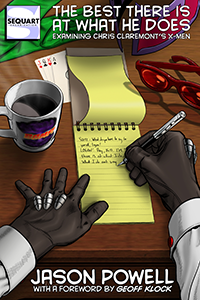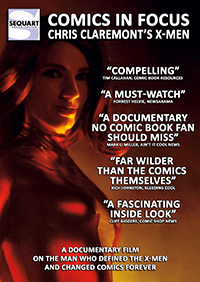…continued from yesterday.
Given that mutants exist, what is to be done with them? That question drives the narrative of the X-Books. The book’s villains—Dr. Bolivar Trask and his Sentinels, the Genoshan Magistrates, Apocalypse, Mr. Sinister, and so on—seek to contain and control the mutants, usually by cruelly oppressive means (camps, experimentation, death). And it has been oft-noted how the comic can be read as a metaphor for the real-world oppression of populations on the basis of biology: apartheid, genocides, the AIDS crisis, homosexuality.
Opposing such oppression is the business of the X-Men, who embody the philosophies and arguments of their leader, Prof. Charles Xavier. They are, ostensibly, the good guys. And yet Xavier’s position, like his opponents, is based on the assumption that mutants must be controlled, in order not to be threats. When Dr. Bolivar Trask argues that mutants are a menace, in X-Men #14 (November 1965), Prof. X replies that a mutant “is not necessarily a menace!” (my emphasis).
Like Trask, like Senator Kelly, like the Genoshans, Prof. X agrees that something needs to be done—that mutants need somehow to be controlled. What differentiates Xavier from his foes is where he locates that control. Whereas the others seek to police mutants by means of oppressive, external forces—giant robots, giant guns, registration acts, concentration camps, slavery, and so on—Xavier proposes an alternative model: one of rigid self-control. Xavier’s solution is a relentless routine of discipline and punishment that the mutant enters into willingly, and which eventually leads to self-mastery. By practicing that model, the X-Men effectively police themselves, thereby staving off other, external forms of regulation and control, both state-sponsored and private.
To this end, Professor X has established an institution, Professor Xavier’s School for Gifted Youngsters, which serves not only as a haven for mutants, but also as a training facility where mutants learn to control their powers. The comic’s early issues dedicate a great many pages to depicting the X-Men training with the intent of mastering and improving their powers. Indeed, the very first issue opens with just such a training session. In the second panel, Prof. X telepathically instructs his students: “You are ordered to appear at once! Class is now in session! Tardiness will be punished!”
The X-Men obey the Professor’s summons, only to be put through a series of obstacle course-like challenges. Their ability to complete these challenges is timed down to the second, as the Professor issues exacting instructions:
“And now, Beast … Grab the taut wire above you with your toes! You have exactly a second and a half! Go! Excellent! Now spin around! Faster! Faster! Pretend an enemy is shooting at you! You must make yourself an impossible target! And now, at my command, release yourself from the taut wire and execute maneuver ‘G’! You have exactly three seconds!”
In the subsequent panel, Cyclops watches Beast follow these commands. He observes: “Three seconds exactly! Well done, Beast!”
In Part 1, I argued that X-Men differs from most other comics in its lack of an origin story. Here we see another way in which X-Men is unique: its characters are super-powered beings who nonetheless must consistently work out. Superman doesn’t need to lift weights to get stronger; he simply is super-strong. So, too, is the Hulk. And while it’s normal for human characters like Batman to work out obsessively, that’s because he doesn’t possess any super-powers.
In the pages of the X-Books, however, it’s presented as a given that the more a mutant practices using his or her power (usually with the assistance of complex and fantastical gymnastics machinery), the greater his or her control over that power will become. The power, too, will also somehow become more powerful. The logic here, I think, is that since the characters are effectively born with their abilities, they can develop them through training, like any other natural talent. In this regard, the X-Men are rather like athletes, or dancers.
Each character’s increased control over his or her powers is usually accompanied by an improvement in musculature and overall fitness, often to an extreme degree. The X-Men may enter the school as teens with ordinary physiques, but after a few months of training, they achieve the highest level of physical conditioning. Every X-Man winds up tremendously muscular and athletic, possessing tremendous reflexes and stamina.
In addition to monitoring his students’ progress in controlling and honing their powers, Professor X also closely monitors their health; indeed, the two are inextricably entwined.
As Xavier remarks: “The Angel has high potential! We must see that he attains it!” As seen from the Beast’s reply—“I’m your boy for high potential, Prof!”—Xavier’s students clamor for the opportunity to be tested, and to be the first to attain such potential.
Furthermore, the optimization of a character’s superpower and physical health is intertwined with a mastery of combat. At Professor X’s institute, all three of these elements are synonymous, because all training is combat training (“Pretend an enemy is shooting at you!”). Here it’s worth noting that one of the original students, the Angel, was recruited by Professor X from a military academy, but what is left unsaid is the fact that Professor Xavier’s school is also a military academy. It is a private military academy where mutant powers are not only regimented and controlled, but militarized. The students train so that they might graduate into a role in Professor X’s paramilitary strike force, the X-Men.
When Jean Grey arrives at the school in X-Men #1, Professor X clarifies that goal for her:
“We have to make our training as rough as possible, to prepare ourselves for our mission in the outside world! … There are many mutants walking the earth … and more are born each year! Not all of them want to help mankind! … Some hate the human race, and wish to destroy it! Some feel that the mutants should be the real rulers of earth! It is our job to protect mankind from those … from the evil mutants!” (11)
What’s left unexamined is why the X-Men need to function as a rogue entity in order to do this, separate from any other governable authority. Instead, the US government is routinely presented as a fearful institution that seeks to dominate all mutants, good and bad.
X-Men #7 (September 1964) sees the characters finally graduate from the school, but not from their training. Professor Xavier compliments them on having mastered the use of their mutant powers “to my complete satisfaction! There is nothing more that I can teach you!” (2) However, the very next issue sees the X-Men once again back at their training, still struggling to master their powers. Cyclops, having been appointed team leader by Professor X, is now the one putting his classmates through their paces, in the exact same manner as his teacher. He instructs Jean Grey: “Let’s see how quickly you can run the thread through the punchboard in a regular pattern! … Exactly six seconds! That beats your previous time!” (3).
Later that page, Beast objects, “I was under the impression our training period had been concluded!” To which Cyclops replies, “Our training can never be ended … and you know that, Hank! Our enemies get stronger every day … and we must always be able to match their own evil progress!” (ibid).
Cyclops’s rationale effectively summarizes the central narrative of the X-Men comics: all of its characters are obsessed with control. Professor X’s students internalize that control, obsessing endlessly over attaining self-mastery [1].
Here it’s worth recalling my earlier point that the book lacks any kind of predictable ending. It is, instead, an ongoing serial narrative whose elements continuously change, but that is effectively going nowhere. Cyclops is correct; an X-Man’s training can never end. The X-Men, having been born mutants, are cursed to continue working out as long as they happen to live. The price of their ex-tra powers is ex-tra discipline. The heroes may struggle toward a particular vision — “humans will come to tolerate mutants” — but that peaceful coexistence depends upon self-mastery and endless training.
To this end, the book’s protagonists are caught up in an endlessly recurring narrative, which we’ll examine more closely in the next two parts.
Notes
[1] Of all the initial X-Men, Cyclops best exemplifies the need for constant self-control, due to his inability to turn off his powers.
Works Cited
X-Men #1. Stan Lee (w), Jack Kirby (p), and Paul Reinman (i). “X-Men.” (Sep. 1963), Marvel Comics.
X-Men #2. Stan Lee (w), Jack Kirby (p), and Paul Reinman (i). “No One Can Stop the Vanisher!” (Nov. 1963), Marvel Comics.
X-Men #7. Stan Lee (w), Jack Kirby (p), and Chic Stone (i). “The Return of the Blob.” (Sep. 1964), Marvel Comics.
X-Men #8. Stan Lee (w), Jack Kirby (p), and Chic Stone (i). “The Uncanny Threat… of Unus the Untouchable!” (Nov. 1964), Marvel Comics.
X-Men #14. Stan Lee (w), Jack Kirby (p), and Chic Stone (i). “Among Us Stalk… the Sentinels!” (Nov. 1964), Marvel Comics.





















































